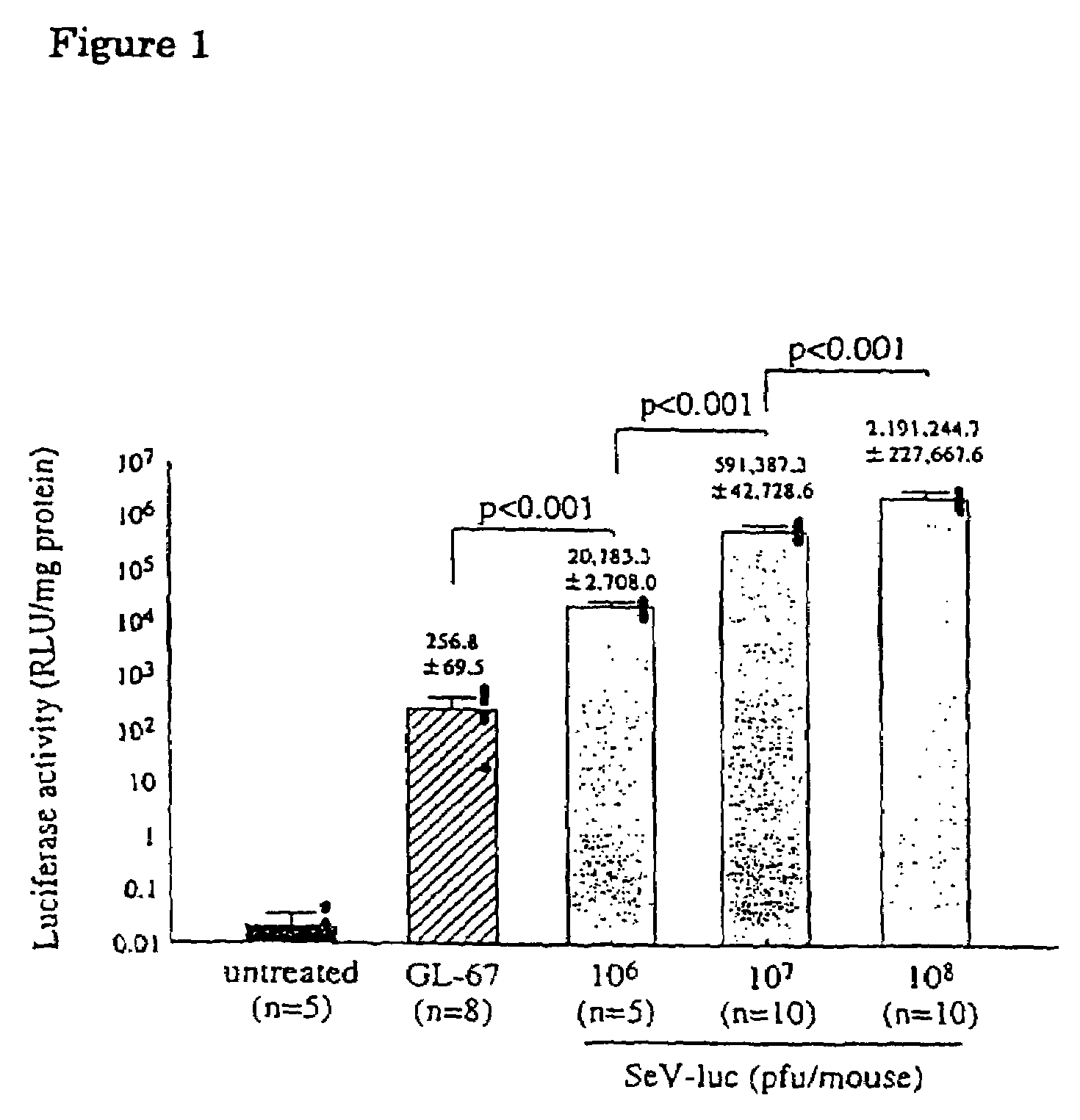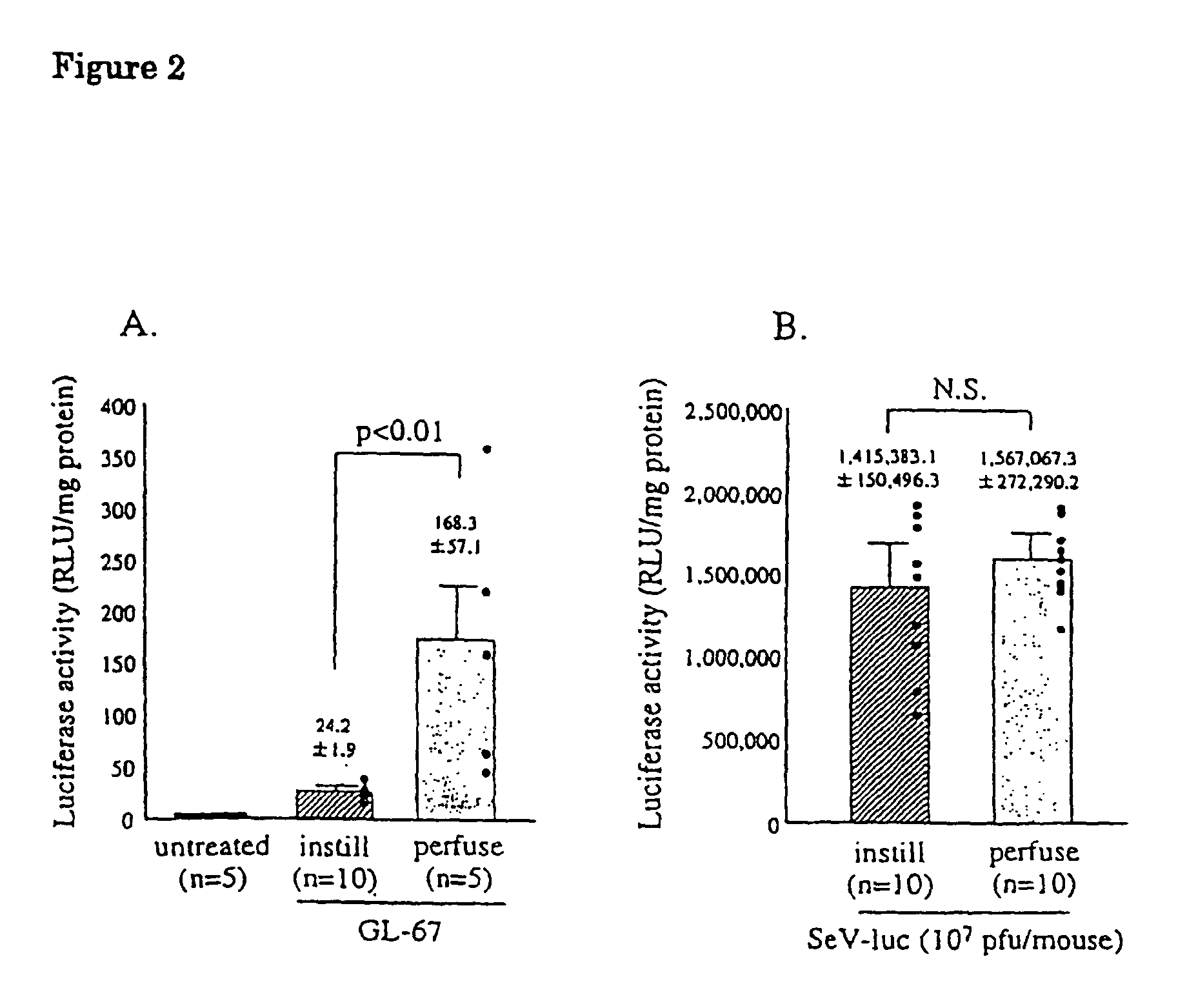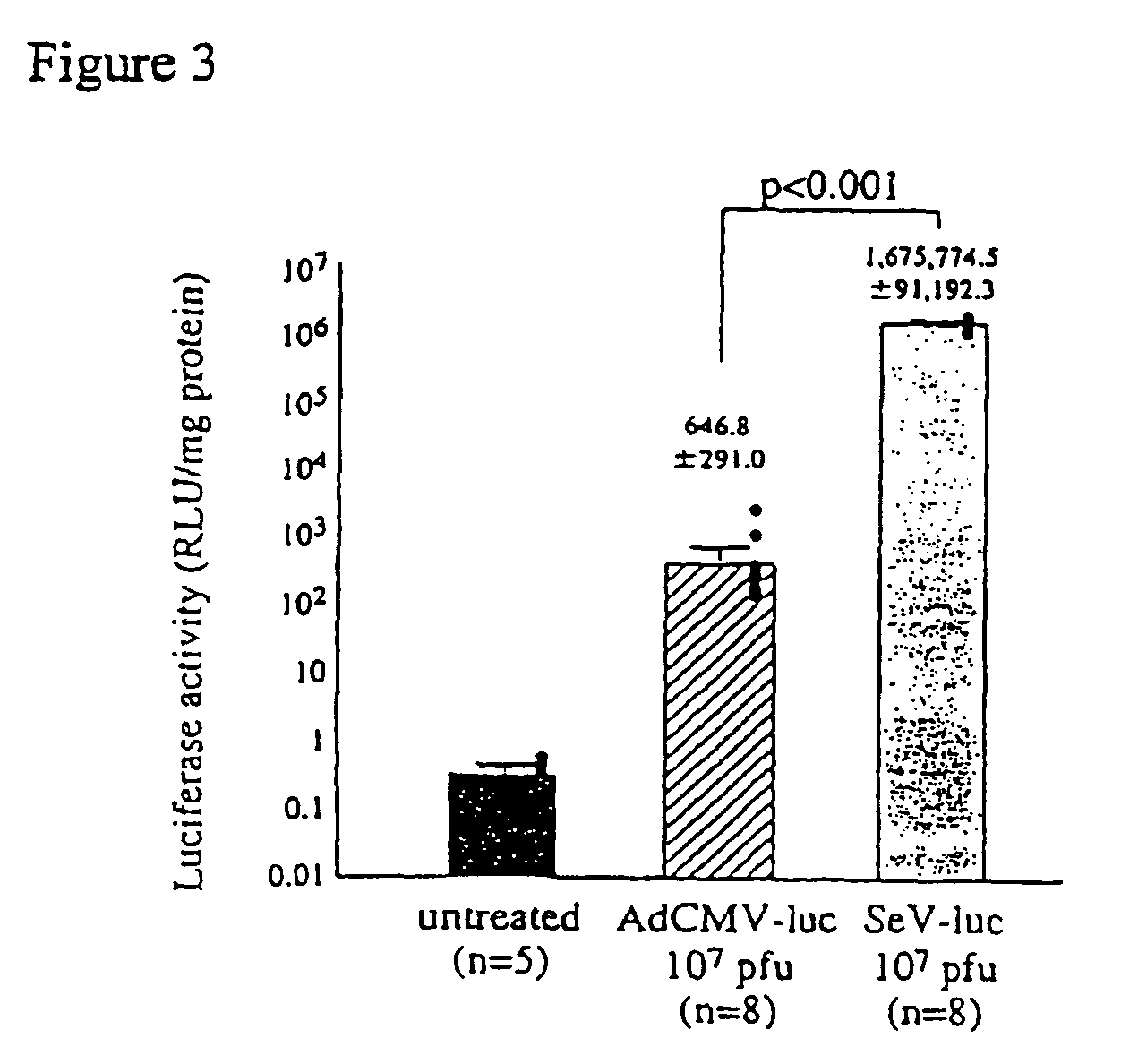Recombinant sendai virus vector for introducing exogenous genes to airway epithelia
a technology of exogenous genes and sendai virus, which is applied in the direction of viruses/bacteriophages, biocide, genetic material ingredients, etc., can solve the problems of inability to transfect cells which are not first removed from the body, inability to use vivo approaches, and loss of new introduced gene function as those cells, etc., to achieve mild affect, not affecting sev infection efficiency, and higher expression
- Summary
- Abstract
- Description
- Claims
- Application Information
AI Technical Summary
Benefits of technology
Problems solved by technology
Method used
Image
Examples
example 1
Construction and Reconstitution of Recombinant Sendai Virus Vector
[0062]A recombinant Sendai virus was constructed by the known method (Kato, A. et al., EMBO J. 16: 578-598, 1997, Hasan, M. K. et al., J. Gen. Verol. 78: 2813-2810, 1997). First, 18 bp of spacer sequence (5′-(G)-CGGCCGCAGATCTTCACG-3′) (SEQ ID NO: 3) with the NotI restriction site was inserted into the proximal locus between the leader sequence and the 5′-end of the sequence encoding N-protein of cloned SeV genomic cDNA, pSeV(+), to obtain plasmid pSeV18+b(+), which also contains a self-cleaving ribozyme site from antigenomic strand of hepatitis delta virus. Whole cDNA of E. coli lacZ containing nuclear localising signal, luciferase, green fluorescent protein (GFP), and E. coli lacZ were amplified by polymerase chain reaction using the primers with the NotI site and new sets of SeVE and S signal sequence-tags for exogenous genes, and inserted into the NotI site of the cloned genome. The whole length of template SeV gen...
example 2
In vivo Gene Transfer to the Mouse Nose and Lung by Nasal Instillation or Nasal Perfusion
2-1. Comparing Sendai Virus Vector with Cationic Lipid
[0063]pCMV-luciferase was constructed by insertion of HindIII-BamHI fragment of pGL3-control vector (Promega), into the multicloning site of pcDNA3 (Invitrogen) to be driven by human cytomegalovirus immediate early (CMV-IE) promoter. pCMV-luciferase was then complexed with GL-67-DOPE-PEG (Genzyme Co. Ltd.) to obtain GL-67-pCMV-luc.
[0064]To examine gene transfer efficiency of the vectors to the lung and the effect of contact time on gene transfer efficiency, the vectors were administered to nasal cavity by nasal instillation and nasal perfusion. First, male balb / c mice (6-8 weeks) were instilled intranasally with 100 μl of various concentration of the Sendai virus vector containing luciferase (SeV-luc) prepared in Example 1 or GL-67-pCMV-luc (80 μg DNA / mouse) by the known method (Yonemitsu, Y. et al., Gene Ther. 4: 631-638, 1997).
[0065]Nasal p...
example 3
Gene transfer to Lung of Ferret
[0074]Ferrets (500-600 g weight) were anaesthetised and instilled intranasally with 3 ml of purified SeV-LacZ in BSS with either 3×108 or 3×109 pfu / ml (n=3 each group), as in Example 2. Controls (n=2) received 3 ml of SeV-Luc (109 pfu / ml). Forty-eight hours post-infection, ferrets were sacrificed, the trachea cannulated in situ and the lungs inflated with ice cold fixative solution (2% formalin, 0.2% glutaraldehyde, 2 mM MgCl2, 5 mM EGTA in PBS, pH 7.3). The trachea and lungs were excised en bloc and underwent X-Gal staining as described in Example 2. Each lung was dissected into 7 parts: trachea, 4 right lobes (upper (R1), mid (R2, R3), and lower (R4)) and 2 left lobes (upper (L1) and lower (L2)), and β-gal positive cells in the airway epithelia and submucosal glands were quantified microscopically by point counting using a graticulated lens. Ten ×20 magnification fields / airway were assessed to obtain the percentage of blue cells / airway and 3 to 8 air...
PUM
| Property | Measurement | Unit |
|---|---|---|
| concentration | aaaaa | aaaaa |
| concentration | aaaaa | aaaaa |
| concentration | aaaaa | aaaaa |
Abstract
Description
Claims
Application Information
 Login to View More
Login to View More - R&D
- Intellectual Property
- Life Sciences
- Materials
- Tech Scout
- Unparalleled Data Quality
- Higher Quality Content
- 60% Fewer Hallucinations
Browse by: Latest US Patents, China's latest patents, Technical Efficacy Thesaurus, Application Domain, Technology Topic, Popular Technical Reports.
© 2025 PatSnap. All rights reserved.Legal|Privacy policy|Modern Slavery Act Transparency Statement|Sitemap|About US| Contact US: help@patsnap.com



